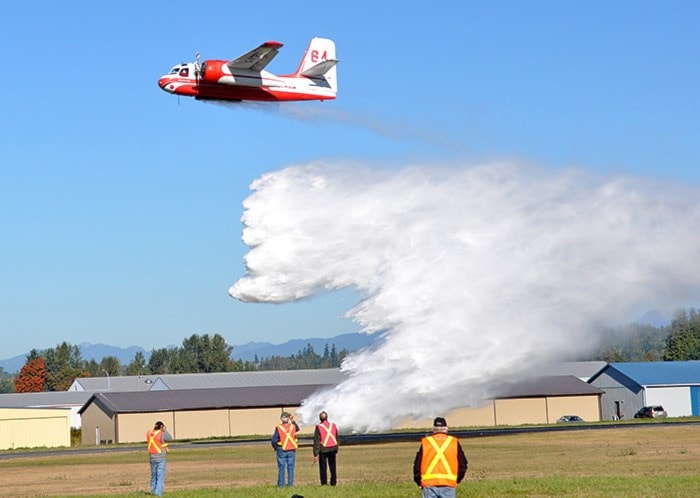
Crowds at the Canadian Museum of Flight witnessed a piece of history on Friday morning as a retired Conair Firecat Air Tanker made its final flight through Langley skies.
Two fly-overs and a ceremonial water drop over Langley Regional Airport marked its last journey before the red plane was parked at the Canadian Museum of Flight.
The Firecat, which was donated to the flight museum by Abbotsford-based Conair Aviation, is the greatest acquisition the centre has ever made, according to Bruce Friesen, vice president of the Canadian Museum of Flight.
“Our job as a museum is to bring British Columbia’s aviation history into the future, to make sure it doesn’t disappear,” said Friesen.
“This plane is B.C. aviation history. For all of us at the museum, this is perhaps the most useful exhibit we could possibly have. We are just so excited.”
Originally built as a CS2F Tracker aircraft in the 1950s, the plane was used to hunt submarines off the deck of the Royal Canadian Navy’s HMCS Bonaventure during the Cold War. When the military retired the fleet in the 1970s, Conair bought the planes and converted them to Firecats to battle fires. They were retired from service in Canada this year, although some are still operating in France.
Obtaining one of the planes for the museum has been a 10-year process for the plane’s final pilots, Bill Findlay, a long-time volunteer with the museum, and Ray Horton, a pilot with Conair for more than 30 years.
The pilots, who are also next-door neighbours, made it their ultimate goal to have a Firecat in Langley as soon as the planes were retired.
They wanted to bring the “airplane home to our original home,” since Conair Aviation originated from Langley’s Skyway Air Services, which operated out of Langley Airport in the 1960s.
“It means so much to the museum to have the aircraft here,” Findlay said. “It’s just the thrill of a lifetime. I’ve been involved in flying for 45 or 50 years and this is right up there with one of those big, big days.”
It’s a big moment for Conair, too, Horton added.
“It’s a real pleasure for us because this was an incredibly successful airplane in our fleet. It’s an icon from our fleet, it’s been in our service for over 30 years,” he said. “
To see them retire is a bit of a tear-shedder, but at the same time we know we are going to have it here on display for people for many, many years to come.”
This was also Findlay’s and Horton’s first flight together, making that moment even more memorable for the two of them.
“Living next to Bill for so long, we’ve never actually flown together,” Horton said. “This was our first flight. It’s a real pleasure to finally get in the sky and do a flight like this in this airplane.
“We’ll be looking back on this for years from now.”
